 Photo 1
Photo 1
Low grade cover weight construction paper with dye colorants for kids, highly light fugitive. Layers need reinforcement.
Children's art consists of many mediums including felt pen, crayon, watercolor, graphite pencil, poster paint, collage and all are precious memorabilia generally having little to no monetary value. When designing for children's art, framers need to take more things into consideration than the obvious questions about color of walls and where it will hang. Technical elements also come under consideration such as medium tolerance (is it heat sensitive); visual enhancement (is this for a child's viewing or for Grandma); and proper long term protection.
Quality of Materials
Since art materials for children are of lesser quality than for artists most may light fade quickly, which calls for UV glazing. The graphite of pencil drawings is very long term but the newsprint paper the drawing is created on will age poorly, yellowing and becoming brittle in time. Unfortunately crepe paper, tissue paper, and construction paper all fade rapidly—sometimes in weeks—and many nontoxic glues and pastes used with children will dry out and fail.
Many pieces may need gentle reinforcement before framing, as the lifting heart in photo 1. Since framers are limited to the amount of repair that may be done—we are not conservators—perhaps additional gluing should be passed on to the customer if needed. When tapes are part of a collage they will dry out and fail in time so that also needs to be pointed out. Your customer needs to be made aware of all issues like this.
 Photo 1
Photo 1
Low grade cover weight construction paper with dye colorants for kids, highly light fugitive. Layers need reinforcement.
To Mount or Not To Mount
Mounting a child's art is an important discussion for a number of reasons. First, these are irreplaceable originals and should be treated as such using reversible preservation techniques such as hinging, corners and sink mounts where applicable. Second, is the paper cockling issue when heavy poster paint is applied to lightweight newsprint paper.
Children's handprints are common preschool art, but poorly stored artwork may become curled, wrinkled, creased and torn. Once the paper fibers have been changed by the moisture in heavy poster paint there is no going back to the flat surface the paper had before it was painted. Sometimes gentle waves in the sheet may be pressed smooth to be hinged or sink mounted. (photo 2) The sample photo shows a badly stored piece that would easily press flat in a warm press though the additional gold cords would need to be removed first.
 Photo 2
Photo 2
Wrinkled paper handprints may smooth in a warm press. Remove any 3D strings and replace after flattening. The difference between waves, cockles and creases is huge.
Other times the prints are on such thin paper they are just badly cockled once dry (photo 3), and you will never be able to truly flatten a cockled handprint enough to mount to any backing board even when the customer insists "...it just needs to be flat." Photo 4 shows a cockled handprint that was pressed flat with no adhesive showing the wavy river lines that resulted. That is the same for any mounting method or adhesive, creases will result.
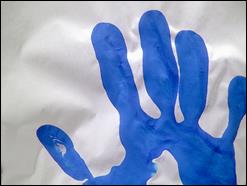 Photo 3
Photo 3
Thickly applied handprints will cockle thin newsprint paper. Any mount will create permanent creases or ripples in the background paper.
 Photo 4
Photo 4
When pressed in a 190ºF mechanical press using no substrate or adhesive, the cockled sample creates a series of very bad ripples across the hand.
Spray adhesive may lightly hold a cockled piece but not smoothly and eventually the adhesive will dry out and fail. Wet glue would stand the test of time but the water content and technique of moistening the paper could damage water base poster paint. Remember that poster paint is not the same as fine art egg tempera, which is waterfast, resulting from the egg white in the medium.
Even preservation mounting has its issues, as cockled waves will show at the edges of a mat window even with a sink mount. (photo 5) The only way to sell an end look to this problem may be with a good set of small 8x10" customer samples to support your explanations. It is often difficult to fully explain what a result may look like.
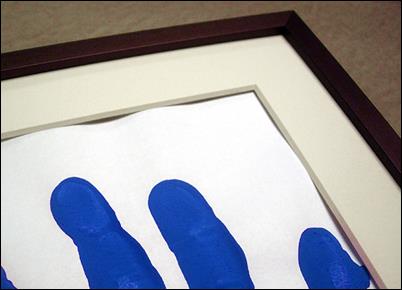 Photo 5
Photo 5
The preservation option is hinges or sink mount. Either will still present wavy paper at the window edges.
Medium Tolerances
It is important to know the tolerances and weaknesses of assorted mediums developed for use with children in relation to mounting options to a rigid board—either for flattening or as support due to frailty. Felt pen and colored markers are dye based and water soluble—because kids write on everything—and they need to be washable which makes them pressure-sensitive and heat tolerant with tissue and film adhesive and HA boards, but is not a candidate for wet mount, and they are light fugitive. Crayons are paraffin wax based having around a 150ºF melting point which limits their dry mount availability to permanent 130ºF MountCor, though P-S and wet mount are options. Watercolor is heat and P-S tolerant but avoid wet glues, and the dye based colors are light sensitive. Poster paint comes as a liquid or powder pigment which uses a gum-water or glue size as its binder making it both heat and P-S tolerant but no wet glue. And being pigment rather than dye it is more lightfast.
Graphite pencil is tolerant of all mounting methods and is totally lightfast—which is why art is signed with pencil. Collage of flat papers and 3D elements such as macaroni, glitter and beads may be dry mounted at most temperatures but requires the sponge mount method (see The Mounting And Laminating Handbook, 3rd Ed, PFM Bookstore) to protect raised surfaces. P-S might work but only through manual application and since it cannot be properly burnished there will be areas that will probably bubble.
Designing for Child vs. Adult
Another consideration is the design of the framing. What is the age of the child and where is the art going to hang? That may sound funny but the maturity of the child, chronological age, and intent for the framing may be a psychological factor in framing choices. If framed for an adult the framing may be more subdued than for a small child. If for a child it could be a circus of bright hot pink and gold or neon green.
A recent project was a felt pen and colored pencil caricature sketch of Luke riding a tiger while visiting the San Diego Zoo. He has mature taste for a six year old child and although the N117236 Cyber Green Nielsen moulding was vibrant and playful he selected a rustic Studio Moulding 6301 Sabi Green because it looked more like the forest a tiger would live in. (photo 6A, 6B)
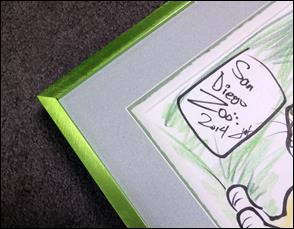
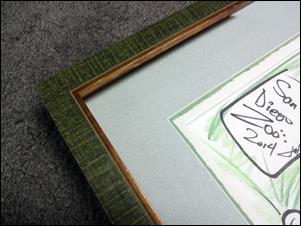 Photo 6
Photo 6
The Nielsen 117236 Cyber Green metal gives a whimsy to the childlike art, but the rustic Studio 6301 Sabi Green offers a more adult appearance.
A chalk drawing created by a 1st grader was uncovered by her mother recently, 20 years after its creation, and she wished to frame it for her now adult daughter as a surprise. The image was damaged from bad storage and since mom wanted two copies—one for her, one for her daughter—it was scanned, digitally repaired and printed to fine art paper. Rather than framing for a child's bedroom it was framed as high end abstract art rather than a 5-year olds interpretive rendering of a horse. (photo 7) It was replicated same size as the original on 100% cotton rag digital fine art paper, but could have been enlarged or printed to canvas for more impact. A standard 1" black stem frame, double Bainbridge 8664 Special crème mat with Cracked Gold Bevel Accent upgraded this masterpiece—of child's art.
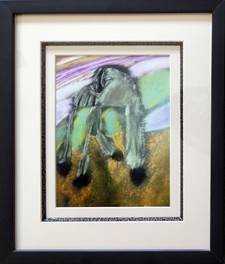
 Photo 7
Photo 7
Chalk drawing digital replica Horse was framed 11¾x14¼""with 1" black stem moulding, double rag and Cracked Gold Bevel Accent spacer.
Caged Heart
Another wonderful piece from 6-year old Luke is Caged Heart a felt pen original. The image has bold primary colors of red and blue with black outlines on white paper. Like Chalk Horse above the drawing has a sophisticated abstract quality that could be capitalized upon. We quickly selected a white liner mat and navy linen top mat but opted for a thin accent paper strip of red with spacers. (photo 8)
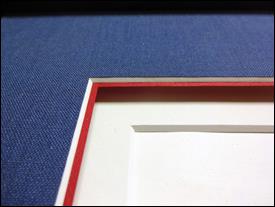 Photo 8
Photo 8
Matted with Crescent 5522 Navy Linen, Bainbridge 8655 Pure White with red accent strip and spacer.
Four moulding choices were selected for Luke to review. (photo 9A, 9B) Larson-Juhl Confetti 140635 Red seemed a little too bold, drawing the eye away from the art to the frame even though it worked with the accent paper and the large heart in the image. LJ Confetti 140640 Blue was good but didn't really do anything special and drew the eye too much to the top blue mat. Nielsen 11752 Bright White was lively and fun but only played to the white background surrounding the image—so Luke selected Nielsen 3421 Matte Black because it "looked like the cage around the heart." (photo 10)
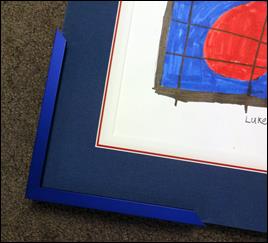
 Photo 9
Photo 9
Four moulding choices were selected for Luke to review: LJ Confetti 140635 Red, Confetti 140640 Blue, Nielsen 11752 Bright White (not shown), and Nielsen 3421 Matte Black.
The final frame selection was not my original choice for a child of his age but how do you fight a sophisticated eye of a budding artist? Upon completion I agreed this was the correct design and even his mother was happy.
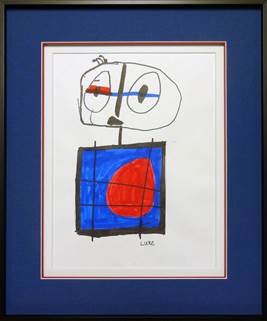 Photo 10
Photo 10
Caged Heart is a felt pen drawing by a 6-year old. Nielsen Matte Black was selected to match the cage.
Final Thoughts
When a project comes in for a child you need to think outside the norm. Brighter colors, whimsical matting and creativity should always be considered and presented, but may not be the right choice for even for a young child. Ask all the questions you would normally ask about colors, placement and such but also ask if it might be for an adult child, grandparent or sibling. Everything can impact a final design.
Never forego the discussion of preservation even when they may think they want it cheap, education is vitally important with framing. And most often they will opt for having a family heirloom for generations over dollars spent. Remember it is never up to you to determine how much any customer can spend.
END
Copyright © 2018 Chris A Paschke
Resources—Items
http://crescentcardboard.com—Matboard
http://dkgroup.com—Mounting adhesives, equipment
http://gilmanbrothers.com—130ºF MountCor, MountCor Canvas
http://kooltack.com—Drymount and Self-adhesive Boards
http://nielsenbainbridgegroup.com—Matboard, Metal Moulding, Bevel Accents
http://studiomoulding.com—Sabi Green Moulding
For more articles on mounting basics look under the mounting section in Articles by Subject.
Additional information on all types of mounting is found in:
The Mounting and Laminating Handbook, Second Edition, 2002,
The Mounting And Laminating Handbook, Third Edition, 2008 and
Creative Mounting, Wrapping, And Laminating, 2000 will teach you everything you need to know about getting the most from your dry mount equipment and materials as an innovative frame designer.
All books are available from Designs Ink Publishing through this website.
Chris A Paschke, CPF GCF
Designs Ink
Designs Ink Publishing
785 Tucker Road, Suite G-183
Tehachapi, CA 93561
P 661-821-2188
chris@designsinkart.com